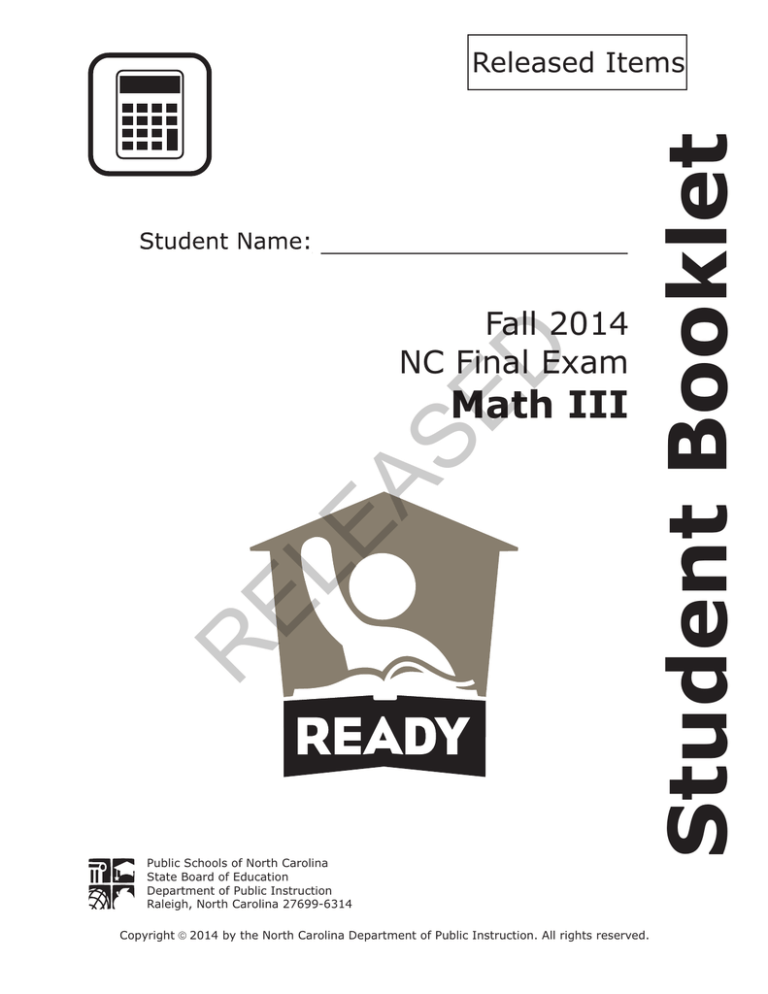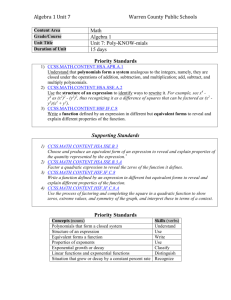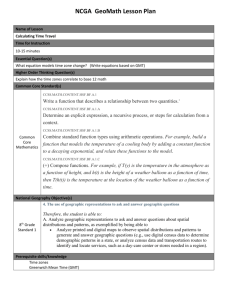
D
Fall 2014
NC Final Exam
R
EL
EA
SE
Math III
Public Schools of North Carolina
State Board of Education
Department of Public Instruction
Raleigh, North Carolina 27699-6314
Copyright ã 2014 by the North Carolina Department of Public Instruction. All rights reserved.
Student Booklet
Released Items
MATH III — RELEASED ITEMS
A
512
B
511
C
256
D
81
D
2
A board is made up of 9 squares. A certain number of pennies is placed in each
square, following a geometric sequence. The first square has 1 penny, the second
has 2 pennies, the third has 4 pennies, etc. When every square is filled, how many
pennies will be used in total?
Let f(x) = 14x3 + 28x2 – 46x and g(x) = 2x + 7. Which is the solution set to the
equation 1 f(x) = g(x)?
B
{ 3, 1, 2}
C
{2, 1, 3}
D
{1, 5, 11}
EL
{3, 0, 1}
The equation 2x2 – 5x = 12 is rewritten in the form of 2(x – p)2 + q = 0. What is
the value of q?
R
3
A
EA
12
SE
1
A
167
16
B
71
8
C
25
8
D
25
16
1
Go to the next page.
MATH III — RELEASED ITEMS
4
A box with an open top will be constructed from a rectangular piece of cardboard.
The piece of cardboard is 8 inches wide and 12 inches long.
The box will be constructed by cutting out equal squares of side x at
each corner and then folding up the sides.
B
0<x<6
C
0<x<8
D
0 < x < 12
SE
0<x<4
EA
A function is shown below.
x 2 2 x for x 3
2x
1
f (x) 2 3
for 3 x 4
2x 5
for x 4
x 7
EL
What is the value of the expression f ( 3) 2f (1) f (4)?
R
5
A
D
What is the entire domain for the function V(x) that gives the volume of the box as
a function of x?
A
101
36
B
32
9
C
4
D
22
2
Go to the next page.
MATH III — RELEASED ITEMS
B
y = ex – 9 – 3
C
y = x2 + 5x + 6
D
y = 3x5 + 4x3 – 11x – 6
A
sin2 cos 2
B
cos 2 sin2
C
2
D
1
sin 4 cos 4
, where sin2 cos 2 ?
sin2 cos 2
SE
Which expression is equivalent to
D
y = log(x) + 100
EA
8
A
The diameter of a circle is 8 centimeters. A central angle of the circle intercepts an
arc of 12 centimeters. What is the radian measure of the angle?
A
3
2
B
3
C
4
D
8
EL
7
Which function goes to positive most quickly as x increases?
R
6
3
Go to the next page.
MATH III — RELEASED ITEMS
What is the value of x in the triangle below?
10
cm
9
60°
5 3 cm
C
10 cm
D
15 cm
SE
B
EA
5 3 cm
2
EL
To completely cover a spherical ball, a ball company uses a total area of 36 square
inches of material. What is the maximum volume the ball can have?
(Note: Surface area of a sphere = 4r 2. Volume of a sphere = 4 r 3. )
3
R
10
A
D
x
A
27 cubic inches
B
36 cubic inches
C
36 cubic inches
D
27 cubic inches
4
Go to the next page.
MATH III — RELEASED ITEMS
11
A farmer wants to buy between 90 and 100 acres of land.
He is interested in a rectangular piece of land that is 1,500 yards long
and 300 yards wide.
The piece of land is being sold as one complete unit for $87,000.
If the farmer does not want to spend more than $900 an acre, does the land meet
all of his requirements? (1 acre ≈ 43,560 ft2)
13
B
No, the price is low enough, but there is too much land.
C
No, the price is low enough, but there is not enough land.
D
No, the amount of land satisfies what he needs, but the price is too high.
SE
D
Yes, the amount of land satisfies his needs, and the price is low enough.
EA
A reporter wants to know the percentage of voters in the state who support
building a new highway. What is the reporter’s population?
the number of people who live in the state
B
the people who were interviewed in the state
C
all voters over 25 years old in the state
D
all eligible voters in the state
EL
A
R
12
A
In a set of test scores that are normally distributed, a test score of 76 is
3 standard deviations below the mean. A score of 88 is 1 standard deviation
above the mean. What is the mean of the data?
A
79
B
82
C
84
D
85
5
Go to the next page.
MATH III — RELEASED ITEMS
This is the end of the Math III Released Items.
Directions:
1. Look back over your answers for the test questions.
2. Make sure all your answers are entered on the answer sheet. Only what is
entered on your answer sheet will be scored.
3. Put all of your papers inside your test book and close the test book.
4. Place your calculator on top of the test book.
5. Stay quietly in your seat until your teacher tells you that testing is
finished.
6. Remember, teachers are not allowed to discuss items from the test with
you, and you are not allowed to discuss with others any of the test
questions or information contained within the test.
6
MATH III — RELEASED ITEMS
Math III
RELEASED Items1
Fall 2014
Answer Key
Type2
Key
Percent Correct3
Standard
1
MC
B
51%
CCSS.Math.Content.HSA.SSE.B.4
2
MC
B
41%
CCSS.Math.Content.HSA.REI.D.11
3
MC
B
30%
CCSS.Math.Content.HSA.REI.B.4.A
4
MC
A
28%
5
MC
D
22%
CCSS.Math.Content.HSF.IF.A.2
6
MC
B
22%
CCSS.Math.Content.HSF.LE.A.3
7
MC
D
21%
CCSS.Math.Content.HSF.TF.C.8
8
MC
B
15%
CCSS.Math.Content.HSF.TF.A.1
11
12
13
SE
EA
EL
10
CCSS.Math.Content.HSF.IF.B.5
MC
D
61%
CCSS.Math.Content.HSG.SRT.B.5
MC
C
38%
CCSS.Math.Content.HSG.MG.A.3
R
9
D
Item Number
MC
D
36%
CCSS.Math.Content.HSG.MG.A.3
MC
D
76%
CCSS.Math.Content.HSS.IC.A.1
MC
D
49%
CCSS.Math.Content.HSS.ID.A.4
1
MATH III — RELEASED ITEMS
1
These released items were administered to students during a previous test administration. This
sample set of released items may not reflect the breadth of the standards assessed and/or the
range of item difficulty found on the NC Final Exam. Additional items may be reviewed at
http://www.ncpublicschools.org/accountability/common-exams/released-forms/. Additional
information about the NC Final Exam is available in the Assessment Specification for each exam
located at http://www.ncpublicschools.org/accountability/common-exams/specifications/.
2
This NC Final Exam contains only multiple-choice (MC) items.
3
R
EL
EA
SE
D
Percent correct is the percentage of students who answered the item correctly during the
Spring 2014 administration.
2
MATH III — RELEASED ITEMS
Standard Descriptions
Only standard descriptions addressed by the released items in this booklet are listed below.
A complete list of standards for English Language Arts and Mathematics may be reviewed at
http://www.corestandards.org/read-the-standards/.
CCSS.Math.Content.HSA.SSE.B.4 (High School: Algebra)
Seeing Structure in Expressions: Write expressions in equivalent forms to solve problems.
Derive the formula for the sum of a finite geometric series (when the common ratio is not 1),
and use the formula to solve problems. For example, calculate mortgage payments.
SE
D
CCSS.Math.Content.HSA.REI.B.4.A (High School: Algebra)
Reasoning with Equations and Inequalities: Solve equations and inequalities in one variable.
Solve quadratic equations in one variable: Use the method of completing the square to
transform any quadratic equation in x into an equation of the form (x – p)2 = q that has the
same solutions. Derive the quadratic formula from this form.
EL
EA
CCSS.Math.Content.HSA.REI.D.11 (High School: Algebra)
Reasoning with Equations and Inequalities: Represent and solve equations and inequalities
graphically. Explain why the x-coordinates of the points where the graphs of the equations
y = f(x) and y = g(x) intersect are the solutions of the equation f(x) = g(x); find the solutions
approximately, e.g., using technology to graph the functions, make tables of values, or find
successive approximations. Include cases where f(x) and/or g(x) are linear, polynomial, rational,
absolute value, exponential, and logarithmic functions.
R
CCSS.Math.Content.HSF.IF.A.2 (High School: Functions)
Interpreting Functions: Understand the concept of a function and use function notation. Use
function notation, evaluate functions for inputs in their domains, and interpret statements that
use function notation in terms of a context.
CCSS.Math.Content.HSF.IF.B.5 (High School: Functions)
Interpreting Functions: Interpret functions that arise in applications in terms of the context.
Relate the domain of a function to its graph and, where applicable, to the quantitative
relationship it describes. For example, if the function h(n) gives the number of person-hours it
takes to assemble n engines in a factory, then the positive integers would be an appropriate
domain for the function.
CCSS.Math.Content.HSF.LE.A.3 (High School: Functions)
Linear, Quadratic, and Expondential Models: Construct and compare linear, quadratic, and
exponential models and solve problems. Observe using graphs and tables that a quantity
increasing exponentially eventually exceeds a quantity increasing linearly, quadratically, or
(more generally) as a polynomial function.
3
MATH III — RELEASED ITEMS
CCSS.Math.Content.HSF.TF.A.1 (High School: Functions)
Trigonometric Functions: Extend the domain of trigonometric functions using the unit circle.
Understand radian measure of an angle as the length of the arc on the unit circle subtended by
the angle.
CCSS.Math.Content.HSF.TF.C.8 (High School: Functions)
Trigonometric Functions: Prove and apply trigonometric identities. Prove the Pythagorean
identity sin2() + cos2() = 1 and use it to find sin(), cos(), or tan() given sin(), cos(), or
tan() and the quadrant of the angle.
D
CCSS.Math.Content.HSG.SRT.B.5 (High School: Geometry)
Similarity, Right Triangles, and Trigonometry: Prove theorems involving similarity. Use
congruence and similarity criteria for triangles to solve problems and to prove relationships in
geometric figures.
SE
CCSS.Math.Content.HSG.MG.A.3 (High School: Geometry)
Modeling with Geometry: Apply geometric concepts in modeling situations. Apply geometric
methods to solve design problems (e.g., designing an object or structure to satisfy physical
constraints or minimize cost; working with typographic grid systems based on ratios).
EL
EA
CCSS.Math.Content.HSS.ID.A.4 (High School: Statistics and Probability)
Interpreting Categorical and Quantitative Data: Summarize, represent, and interpret data on a
single count or measurement variable. Use the mean and standard deviation of a data set to fit
it to a normal distribution and to estimate population percentages. Recognize that there are data
sets for which such a procedure is not appropriate. Use calculators, spreadsheets, and tables to
estimate areas under the normal curve.
R
CCSS.Math.Content.HSS.IC.A.1 (High School: Statistics and Probability)
Making Inferences and Justifying Conclusions: Understand and evaluate random processes
underlying statistical Experiments. Understand statistics as a process for making inferences
about population parameters based on a random sample from that population.
4







